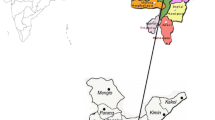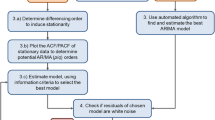Abstract
This article introduces a new version of first-order binomial autoregressive (BAR(1)) process with zero-and-one inflated binomial marginals using the idea of hidden Markov models, which contains the BAR(1) and other existing processes as special cases. Stochastic properties of the new model are investigated and model parameters are estimated by the probability-based, quasi-maximum likelihood, maximum likelihood and Bayesian methods. A binomial one-inflation index is constructed and further utilized to develop a method to test whether zero and/or one inflation with respect to a BAR(1) model. We also give the asymptotic distribution of the corresponding test statistics under the null hypothesis. Applications to rainy-days and assaults-on-officers counts are conducted, which shows that the proposed model can accurately capture zero-inflation, one-inflation and overdispersion characteristics of the data. The predictive distributions are employed to identify the occurrence of anomalies and then establish early warning system of risk.





Similar content being viewed by others
References
Box GEP, Jenkins GM, Reinsel GC (1994) Time Series Analysis-Forecasting and Control. Prentice Hall, New Jersey
Chen CWS, Watanabe T (2019) Bayesian modeling and forecasting of Value-at-Risk via threshold realized volatility. Appl Stoch Model Bus Ind 35:747–765
Chen H, Li Q, Zhu F (2020) Two classes of dynamic binomial integer-valued ARCH models. Braz J Probab Stat 34:685–711
Chen H, Li Q, Zhu F (2021) Binomial AR(1) processes with innovational outliers. Commun Stat Theory Methods 50:446–472
Cui Y, Lund R (2010) Inference in binomial AR(1) models. Stat Probab Lett 80:1985–1990
Freeland RK, McCabe BPM (2004) Forecasting discrete valued low count time series. Int J Forecast 20:427–434
Jazi MA, Jones G, Lai CD (2012) First-order integer valued AR processes with zero-inflated poisson innovations. J Time Ser Anal 33:954–963
Kang Y, Wang D, Yang K (2020) Extended binomial AR(1) processes with generalized binomial thinning operator. Commun Stat Theory Methods 49:3498–3520
Kang Y, Wang D, Yang K (2021) A new INAR(1) process with bounded support for counts showing equidispersion, underdispersion and overdispersion. Stat Pap 62:745–767
Kim HY, Weiß CH (2015) Goodness-of-fit tests for binomial AR(1) processes. Statistics 49:291–315
Kim HY, Weiß CH, Möller TA (2018) Testing for an excessive number of zeros in time series of bounded counts. Stat Methods Appl 27:689–714
Kumaraswamy P (1980) A generalized probability density function for double bounded random processes. J Hydrol 46:79–88
Li C, Wang D, Zhang H (2015) First-order mixed integer-valued autoregressive processes with zero-inflated generalized power series innovations. J Korean Stat Soc 44:232–246
Liu M, Zhu F, Zhu K (2022) Modeling normalcy-dominant ordinal time series: an application to air quality level. J Time Ser Anal 43:460–478
Maiti R, Biswas A (2017) Coherent forecasting for stationary time series of discrete data. AStA Adv Stat Anal 99:337–365
Maiti R, Biswas A, Chakraborty B (2018) Modelling of low count heavy tailed time series data consisting large number of zeros and ones. Stat Methods Appl 27:407–435
McKenzie E (1985) Some simple models for discrete variate time series. Water Resour Bull 21:645–650
Mohammadi Z, Sajjadnia Z, Bakouch HS, Sharafi M (2022) Zero-and-one inflated Poisson-Lindley INAR (1) process for modelling count time series with extra zeros and ones. J Stat Comput Simul 92:2018–2040
Möller TA, Silva ME, Weiß CH, Scotto MG, Pereira I (2016) Self-exciting threshold binomial autoregressive processes. AStA Adv Stat Anal 100:369–400
Möller TA, Weiß CH, Kim HY (2020) Modelling counts with state-dependent zero inflation. Stat Model 20:127–147
Möller TA, Weiß CH, Kim HY, Sirchenko A (2018) Modeling zero inflation in count data time series with bounded support. Methodol Comput Appl Probab 20:589–609
Perumean-Chaney SE, Morgan C, McDowall D, Aban I (2013) Zero-inflated and overdispersed: what’s one to do? J Stat Comput Simul 83:1671–1683
Qi X, Li Q, Zhu F (2019) Modelling time series of count with excess zeros and ones based on INAR(1) model with zero-and-one inflated poisson innovations. J Comput Appl Math 346:572–590
Ridout M, Demétrio CGB, Hinde J (1998) Models for count data with many zeros. In: Proceedings of the 19th international biometric conference. Cape Town, South Africa, pp 179–190
Ristić MM, Popović B (2019) A new bivariate binomial time series model. Markov Process Relat Fields 25:1–26
Schweer S (2015) On the time-reversibility of integer-valued autoregressive processes of general order. In: Steland A et al (eds) Stochastic models, statistics and their applications. Springer, Berlin, pp 169–177
Scotto MG, Weiß CH, Silva ME, Pereira I (2014) Bivariate binomial autoregressive models. J Multivar Anal 125:233–251
Steutel FW, Van Harn K (1979) Discrete analogues of self-decomposability and stability. Ann Probab 7:893–899
Weiß CH (2009) Jumps in binomial AR(1) processes. Stat Probab Lett 79:2012–2019
Weiß CH (2009) Monitoring correlated processes with binomial marginals. J Appl Stat 36:399–414
Weiß CH, Kim HY (2013) Binomial AR(1) processes: moments, cumulants, and estimation. Statistics 47:494–510
Weiß CH, Kim HY (2013) Parameter estimation for binomial AR(1) models with applications in finance and industry. Stat Pap 54:563–590
Weiß CH, Kim HY (2015) Diagnosing and modeling extra-binomial variation for time-dependent counts. Appl Stoch Model Bus Ind 30:588–608
Weiß CH, Pollett PK (2012) Chain binomial models and binomial autoregressive processes. Biometrics 68:815–824
Weiß (2013) Integer-valued autoregressive models for counts showing underdispersion. J Appl Stat 40:1931–1948
Weiß CH, Pollett PK (2014) Binomial autoregressive processes with density-dependent thinning. J Time Ser Anal 35:115–132
Yang K, Wang D, Li H (2017) Threshold autoregression analysis for finite range time series of counts with an application on measles data. J Stat Comput Simul 88:597–614
Zhu F (2012) Zero-inflated Poisson and negative binomial integer-valued GARCH models. J Stat Plan Inference 142:826–839
Zucchini W, MacDonald IL, Langrock R (2009) Hidden Markov models for time series: an introduction using R. Chapman & Hall, London
Zuur AF, Ieno EN, Walker NJ, Saveliev AA, Smith GM (2009) Mixed effects models and extensions in ecology with R. Springer, New York
Acknowledgements
We are very grateful to the AE and anonymous referees for providing several constructive and helpful comments which led to a significant improvement of the paper. Kang is supported by National Natural Science Foundation of China (NSFC) (No. 12101485) and China Postdoctoral Science Foundation (No. 2021M702624). Wang is supported by NSFC (Nos. 11871028 and 11731015). Zhu is supported by NSFC (Nos. 11871027 and 11731015) and Natural Science Foundation of Jilin Province (No. 20210101143JC).
Author information
Authors and Affiliations
Corresponding author
Additional information
Publisher's Note
Springer Nature remains neutral with regard to jurisdictional claims in published maps and institutional affiliations.
Supplementary Information
Below is the link to the electronic supplementary material.
Rights and permissions
Springer Nature or its licensor holds exclusive rights to this article under a publishing agreement with the author(s) or other rightsholder(s); author self-archiving of the accepted manuscript version of this article is solely governed by the terms of such publishing agreement and applicable law.
Springer Nature or its licensor holds exclusive rights to this article under a publishing agreement with the author(s) or other rightsholder(s); author self-archiving of the accepted manuscript version of this article is solely governed by the terms of such publishing agreement and applicable law.
About this article
Cite this article
Kang, Y., Wang, S., Wang, D. et al. Analysis of zero-and-one inflated bounded count time series with applications to climate and crime data. TEST 32, 34–73 (2023). https://doi.org/10.1007/s11749-022-00825-y
Received:
Accepted:
Published:
Issue Date:
DOI: https://doi.org/10.1007/s11749-022-00825-y




